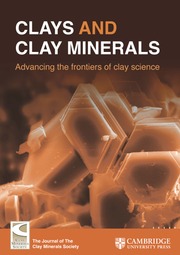Crossref Citations
This article has been cited by the following publications. This list is generated based on data provided by
Crossref.
Koch, Michel H. J.
and
Bras, Wim
2008.
Synchrotron radiation studies of non-crystalline systems.
Annual Reports Section "C" (Physical Chemistry),
Vol. 104,
Issue. ,
p.
35.
Souza, D.H.S.
Dahmouche, K.
Andrade, C.T.
and
Dias, M.L.
2011.
Structure, morphology and thermal stability of synthetic fluorine mica and its organic derivatives.
Applied Clay Science,
Vol. 54,
Issue. 3-4,
p.
226.
Birkenstock, J.
Kleemeier, M.
Vogt, C.
Wendschuh, M.
Hartwig, A.
and
Fischer, R.X.
2011.
Influence of sodium bromide on the thermal decomposition of tetraphenylphosphonium montmorillonite.
Applied Clay Science,
Vol. 54,
Issue. 2,
p.
144.
Burger, C.
Hsiao, B.S.
and
Chu, B.
2012.
Polymer Science: A Comprehensive Reference.
p.
363.
Jeschke, Gunnar
2012.
Characterization Techniques for Polymer Nanocomposites.
p.
229.
Schlick, S.
and
Jeschke, G.
2012.
Polymer Science: A Comprehensive Reference.
p.
221.
Souza, Diego H. S.
Borges, Soraia V.
Dias, Marcos L.
and
Andrade, Cristina T.
2012.
Structural evaluation and thermal properties of poly(lactic acid) and different synthetic micas nanocomposites.
Polymer Composites,
Vol. 33,
Issue. 4,
p.
555.
Borges, Soraia V
Dias, Marcos L
Pita, Victor JRR
Azuma, Chiaki
and
Dias, Marali V
2013.
Water vapor permeability and tensile properties of poly(l-lactic acid)/synthetic mica nanocomposites prepared by melt blending.
Journal of Plastic Film & Sheeting,
Vol. 29,
Issue. 2,
p.
112.
Kiersnowski, Adam
Kolman, Krzysztof
Lieberwirth, Ingo
Yordanov, Stoyan
Butt, Hans-Jürgen
Hansen, Michael Ryan
and
Anastasiadis, Spiros H.
2013.
New insights into the multilevel structure and phase transitions of synthetic organoclays.
Soft Matter,
Vol. 9,
Issue. 7,
p.
2291.
Kooli, Fethi
2013.
Effect of C16TMA contents on the thermal stability of organo-bentonites: In situ X-ray diffraction analysis.
Thermochimica Acta,
Vol. 551,
Issue. ,
p.
7.
Bardziński, Piotr Józef
2014.
On the impact of intermolecular interactions between the quaternary ammonium ions on interlayer spacing of quat-intercalated montmorillonite: A molecular mechanics and ab-initio study.
Applied Clay Science,
Vol. 95,
Issue. ,
p.
323.
Borges, Soraia V
Dias, Marcos L
Pita, Victor JRR
Azuma, Chiaki
and
Dias, Marali V
2014.
Processability, morphology and thermal behavior of poly(lactic acid)/synthetic mica nanocomposites obtained by melt blending.
Journal of Composite Materials,
Vol. 48,
Issue. 12,
p.
1429.
Zhu, Yingdong
Edwards, Grant A.
and
Martin, Darren J.
2015.
Reduction of aspect ratio of fluoromica using high-energy milling.
Applied Clay Science,
Vol. 114,
Issue. ,
p.
315.
Hu, Lei
Leclair, Έric
Poulin, Mado
Colas, Fabienne
Baldet, Patrick
and
Vuillaume, Pascal Y.
2016.
Clay/Polyethylene Composites with Enhanced Barrier Properties for Seed Storage.
Polymers and Polymer Composites,
Vol. 24,
Issue. 6,
p.
387.
Honorato, Luciana
Dias, Marcos Lopes
Azuma, Chiaki
and
Nunes, Regina Célia Reis
2016.
Rheological properties and curing features of natural rubber compositions filled with fluoromica ME 100.
Polímeros,
Vol. 26,
Issue. 3,
p.
249.
Pálková, Helena
Zimowska, Małgorzata
Jankovič, Ľuboš
Sulikowski, Bogdan
Serwicka, Ewa M.
and
Madejová, Jana
2017.
Thermal stability of tetrabutyl-phosphonium and -ammonium exchanged montmorillonite: Influence of acid treatment.
Applied Clay Science,
Vol. 138,
Issue. ,
p.
63.
Linhares, Felipe N.
Gabriel, Cléverson F.S.
de Sousa, Ana Maria F.
and
Nunes, Regina Célia Reis
2018.
Mechanical and rheological properties of nitrile rubber/fluoromica composites.
Applied Clay Science,
Vol. 162,
Issue. ,
p.
165.
Khoza, Mary
Bandyopadhyay, Jayita
Ray, Suprakas Sinha
and
Ojijo, Vincent
2020.
Qualitative assessment on the surfactant traces from the organically modified nanoclay containing polymer nanocomposite.
Vol. 2309,
Issue. ,
p.
020072.
Nunes, Janis Schutte
Ito, Edson Noriyuki
Gabriel, Cléverson Fernandes Senra
Lopes, Thiago Castro
and
Nunes, Regina Célia Reis
2022.
Physical-mechanical behavior of nitrile rubber-synthetic mica nanocomposites.
Polímeros,
Vol. 32,
Issue. 2,

